ITC571 Project Proposal: Wearable Devices & Remote Health Monitoring
VerifiedAdded on 2024/06/28
|6
|1384
|156
Project
AI Summary
This project proposal explores the use of IoT and wearable devices for remote health monitoring to improve healthcare accessibility, particularly for elderly and disabled individuals. It identifies the shortcomings of current remote health monitoring solutions and proposes an enhanced framework using wearable devices like armbands, smartwatches, and smart clothing to collect precise health information. The research aims to answer questions related to current healthcare monitoring issues, the impact of wearable technology, and the benefits for vulnerable populations. The proposed methodology includes a literature review, data gathering, and the development of an enhanced framework integrating IoT and wearable devices for cost-effective and timely healthcare interventions, ultimately improving wellness and reducing mortality rates.
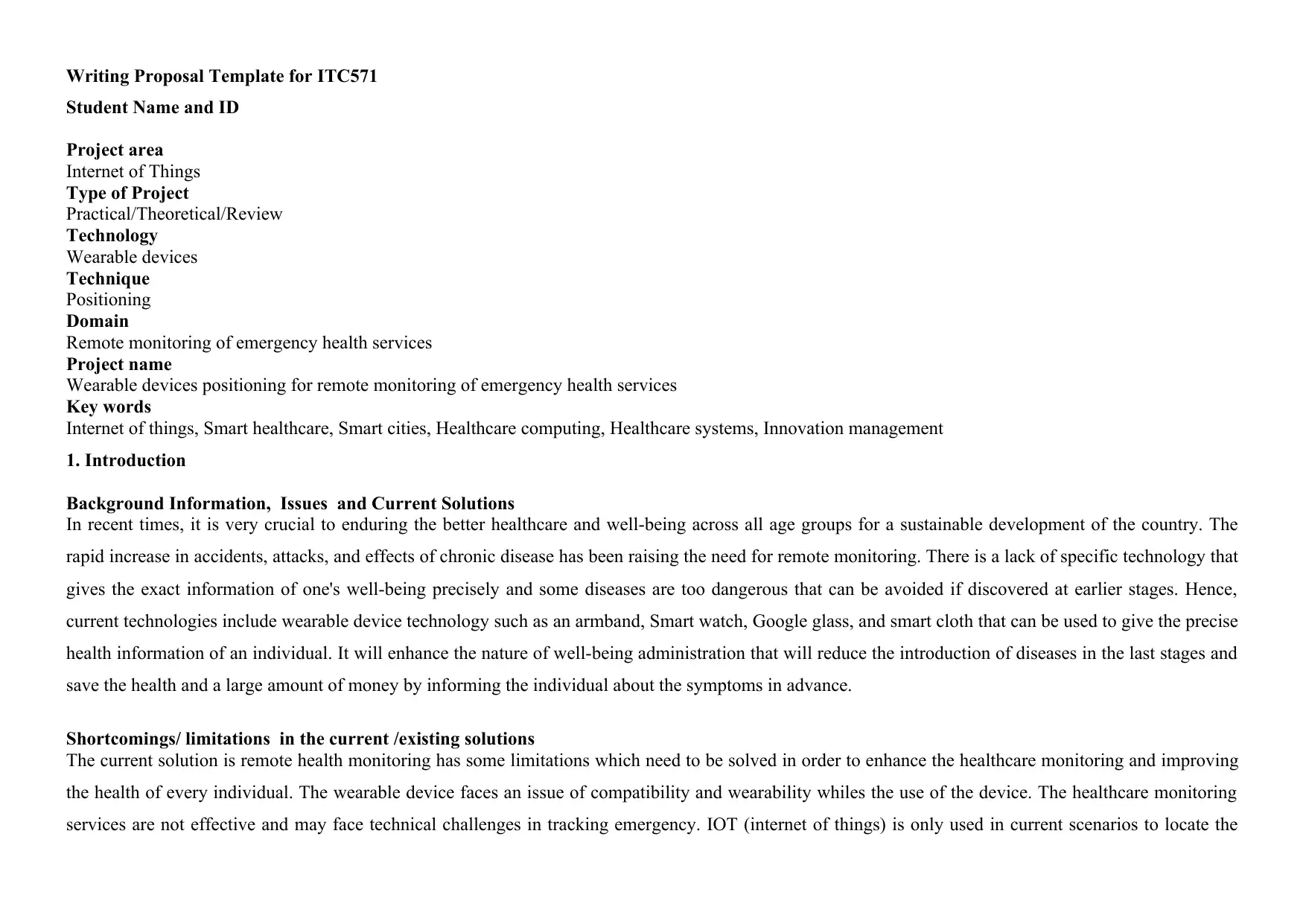
Writing Proposal Template for ITC571
Student Name and ID
Project area
Internet of Things
Type of Project
Practical/Theoretical/Review
Technology
Wearable devices
Technique
Positioning
Domain
Remote monitoring of emergency health services
Project name
Wearable devices positioning for remote monitoring of emergency health services
Key words
Internet of things, Smart healthcare, Smart cities, Healthcare computing, Healthcare systems, Innovation management
1. Introduction
Background Information, Issues and Current Solutions
In recent times, it is very crucial to enduring the better healthcare and well-being across all age groups for a sustainable development of the country. The
rapid increase in accidents, attacks, and effects of chronic disease has been raising the need for remote monitoring. There is a lack of specific technology that
gives the exact information of one's well-being precisely and some diseases are too dangerous that can be avoided if discovered at earlier stages. Hence,
current technologies include wearable device technology such as an armband, Smart watch, Google glass, and smart cloth that can be used to give the precise
health information of an individual. It will enhance the nature of well-being administration that will reduce the introduction of diseases in the last stages and
save the health and a large amount of money by informing the individual about the symptoms in advance.
Shortcomings/ limitations in the current /existing solutions
The current solution is remote health monitoring has some limitations which need to be solved in order to enhance the healthcare monitoring and improving
the health of every individual. The wearable device faces an issue of compatibility and wearability whiles the use of the device. The healthcare monitoring
services are not effective and may face technical challenges in tracking emergency. IOT (internet of things) is only used in current scenarios to locate the
Student Name and ID
Project area
Internet of Things
Type of Project
Practical/Theoretical/Review
Technology
Wearable devices
Technique
Positioning
Domain
Remote monitoring of emergency health services
Project name
Wearable devices positioning for remote monitoring of emergency health services
Key words
Internet of things, Smart healthcare, Smart cities, Healthcare computing, Healthcare systems, Innovation management
1. Introduction
Background Information, Issues and Current Solutions
In recent times, it is very crucial to enduring the better healthcare and well-being across all age groups for a sustainable development of the country. The
rapid increase in accidents, attacks, and effects of chronic disease has been raising the need for remote monitoring. There is a lack of specific technology that
gives the exact information of one's well-being precisely and some diseases are too dangerous that can be avoided if discovered at earlier stages. Hence,
current technologies include wearable device technology such as an armband, Smart watch, Google glass, and smart cloth that can be used to give the precise
health information of an individual. It will enhance the nature of well-being administration that will reduce the introduction of diseases in the last stages and
save the health and a large amount of money by informing the individual about the symptoms in advance.
Shortcomings/ limitations in the current /existing solutions
The current solution is remote health monitoring has some limitations which need to be solved in order to enhance the healthcare monitoring and improving
the health of every individual. The wearable device faces an issue of compatibility and wearability whiles the use of the device. The healthcare monitoring
services are not effective and may face technical challenges in tracking emergency. IOT (internet of things) is only used in current scenarios to locate the
Paraphrase This Document
Need a fresh take? Get an instant paraphrase of this document with our AI Paraphraser
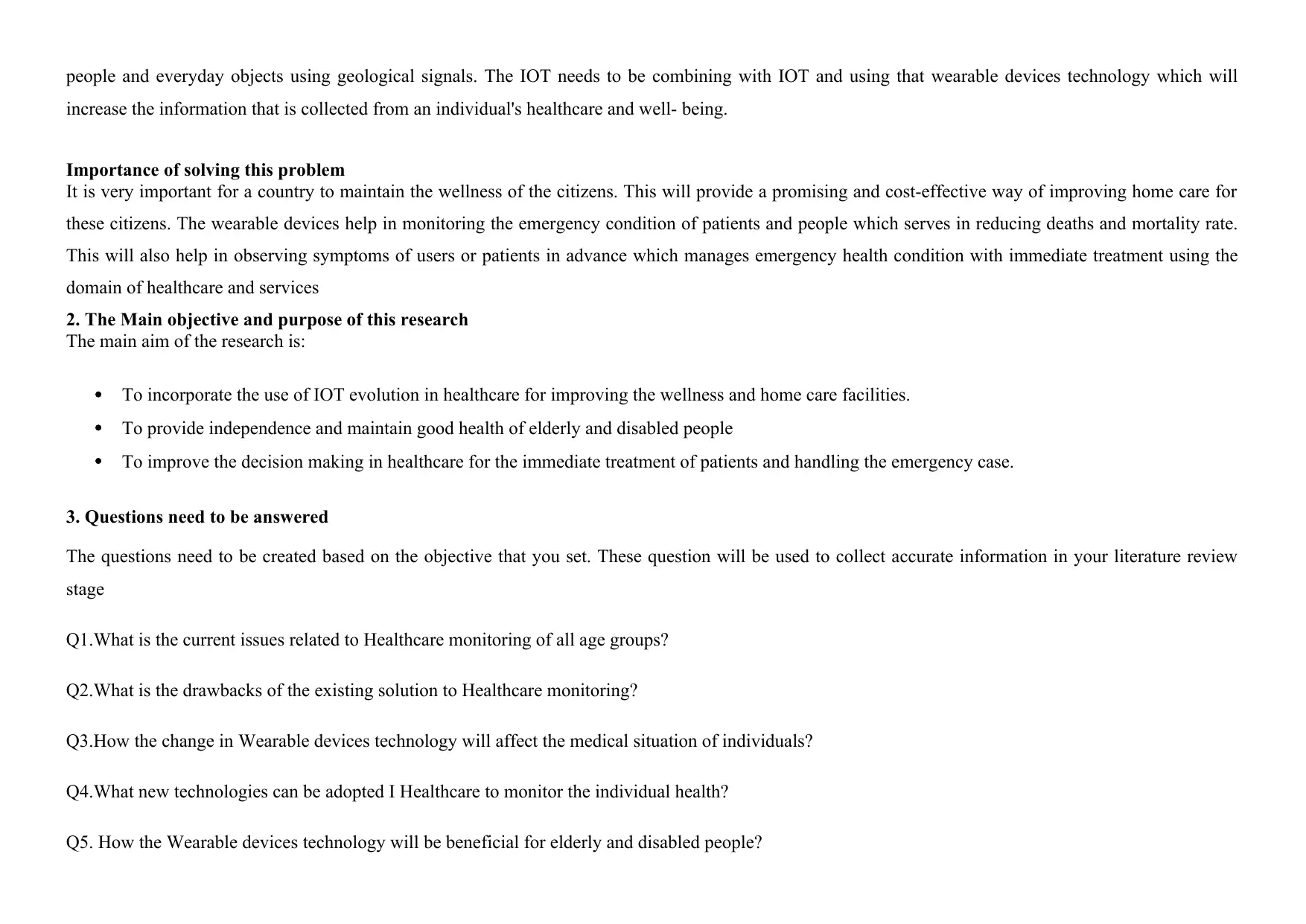
people and everyday objects using geological signals. The IOT needs to be combining with IOT and using that wearable devices technology which will
increase the information that is collected from an individual's healthcare and well- being.
Importance of solving this problem
It is very important for a country to maintain the wellness of the citizens. This will provide a promising and cost-effective way of improving home care for
these citizens. The wearable devices help in monitoring the emergency condition of patients and people which serves in reducing deaths and mortality rate.
This will also help in observing symptoms of users or patients in advance which manages emergency health condition with immediate treatment using the
domain of healthcare and services
2. The Main objective and purpose of this research
The main aim of the research is:
To incorporate the use of IOT evolution in healthcare for improving the wellness and home care facilities.
To provide independence and maintain good health of elderly and disabled people
To improve the decision making in healthcare for the immediate treatment of patients and handling the emergency case.
3. Questions need to be answered
The questions need to be created based on the objective that you set. These question will be used to collect accurate information in your literature review
stage
Q1.What is the current issues related to Healthcare monitoring of all age groups?
Q2.What is the drawbacks of the existing solution to Healthcare monitoring?
Q3.How the change in Wearable devices technology will affect the medical situation of individuals?
Q4.What new technologies can be adopted I Healthcare to monitor the individual health?
Q5. How the Wearable devices technology will be beneficial for elderly and disabled people?
increase the information that is collected from an individual's healthcare and well- being.
Importance of solving this problem
It is very important for a country to maintain the wellness of the citizens. This will provide a promising and cost-effective way of improving home care for
these citizens. The wearable devices help in monitoring the emergency condition of patients and people which serves in reducing deaths and mortality rate.
This will also help in observing symptoms of users or patients in advance which manages emergency health condition with immediate treatment using the
domain of healthcare and services
2. The Main objective and purpose of this research
The main aim of the research is:
To incorporate the use of IOT evolution in healthcare for improving the wellness and home care facilities.
To provide independence and maintain good health of elderly and disabled people
To improve the decision making in healthcare for the immediate treatment of patients and handling the emergency case.
3. Questions need to be answered
The questions need to be created based on the objective that you set. These question will be used to collect accurate information in your literature review
stage
Q1.What is the current issues related to Healthcare monitoring of all age groups?
Q2.What is the drawbacks of the existing solution to Healthcare monitoring?
Q3.How the change in Wearable devices technology will affect the medical situation of individuals?
Q4.What new technologies can be adopted I Healthcare to monitor the individual health?
Q5. How the Wearable devices technology will be beneficial for elderly and disabled people?
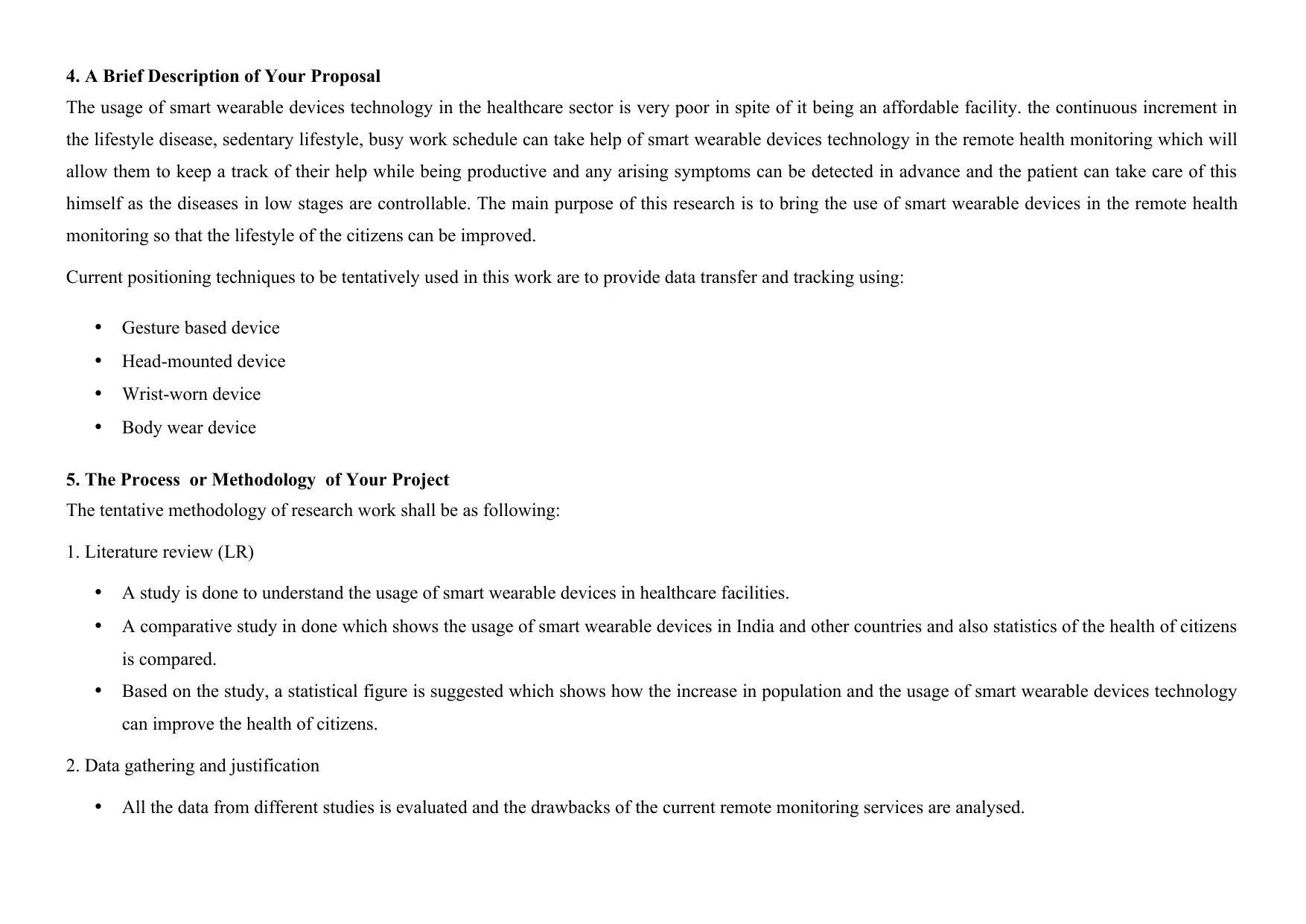
4. A Brief Description of Your Proposal
The usage of smart wearable devices technology in the healthcare sector is very poor in spite of it being an affordable facility. the continuous increment in
the lifestyle disease, sedentary lifestyle, busy work schedule can take help of smart wearable devices technology in the remote health monitoring which will
allow them to keep a track of their help while being productive and any arising symptoms can be detected in advance and the patient can take care of this
himself as the diseases in low stages are controllable. The main purpose of this research is to bring the use of smart wearable devices in the remote health
monitoring so that the lifestyle of the citizens can be improved.
Current positioning techniques to be tentatively used in this work are to provide data transfer and tracking using:
Gesture based device
Head-mounted device
Wrist-worn device
Body wear device
5. The Process or Methodology of Your Project
The tentative methodology of research work shall be as following:
1. Literature review (LR)
A study is done to understand the usage of smart wearable devices in healthcare facilities.
A comparative study in done which shows the usage of smart wearable devices in India and other countries and also statistics of the health of citizens
is compared.
Based on the study, a statistical figure is suggested which shows how the increase in population and the usage of smart wearable devices technology
can improve the health of citizens.
2. Data gathering and justification
All the data from different studies is evaluated and the drawbacks of the current remote monitoring services are analysed.
The usage of smart wearable devices technology in the healthcare sector is very poor in spite of it being an affordable facility. the continuous increment in
the lifestyle disease, sedentary lifestyle, busy work schedule can take help of smart wearable devices technology in the remote health monitoring which will
allow them to keep a track of their help while being productive and any arising symptoms can be detected in advance and the patient can take care of this
himself as the diseases in low stages are controllable. The main purpose of this research is to bring the use of smart wearable devices in the remote health
monitoring so that the lifestyle of the citizens can be improved.
Current positioning techniques to be tentatively used in this work are to provide data transfer and tracking using:
Gesture based device
Head-mounted device
Wrist-worn device
Body wear device
5. The Process or Methodology of Your Project
The tentative methodology of research work shall be as following:
1. Literature review (LR)
A study is done to understand the usage of smart wearable devices in healthcare facilities.
A comparative study in done which shows the usage of smart wearable devices in India and other countries and also statistics of the health of citizens
is compared.
Based on the study, a statistical figure is suggested which shows how the increase in population and the usage of smart wearable devices technology
can improve the health of citizens.
2. Data gathering and justification
All the data from different studies is evaluated and the drawbacks of the current remote monitoring services are analysed.
⊘ This is a preview!⊘
Do you want full access?
Subscribe today to unlock all pages.

Trusted by 1+ million students worldwide
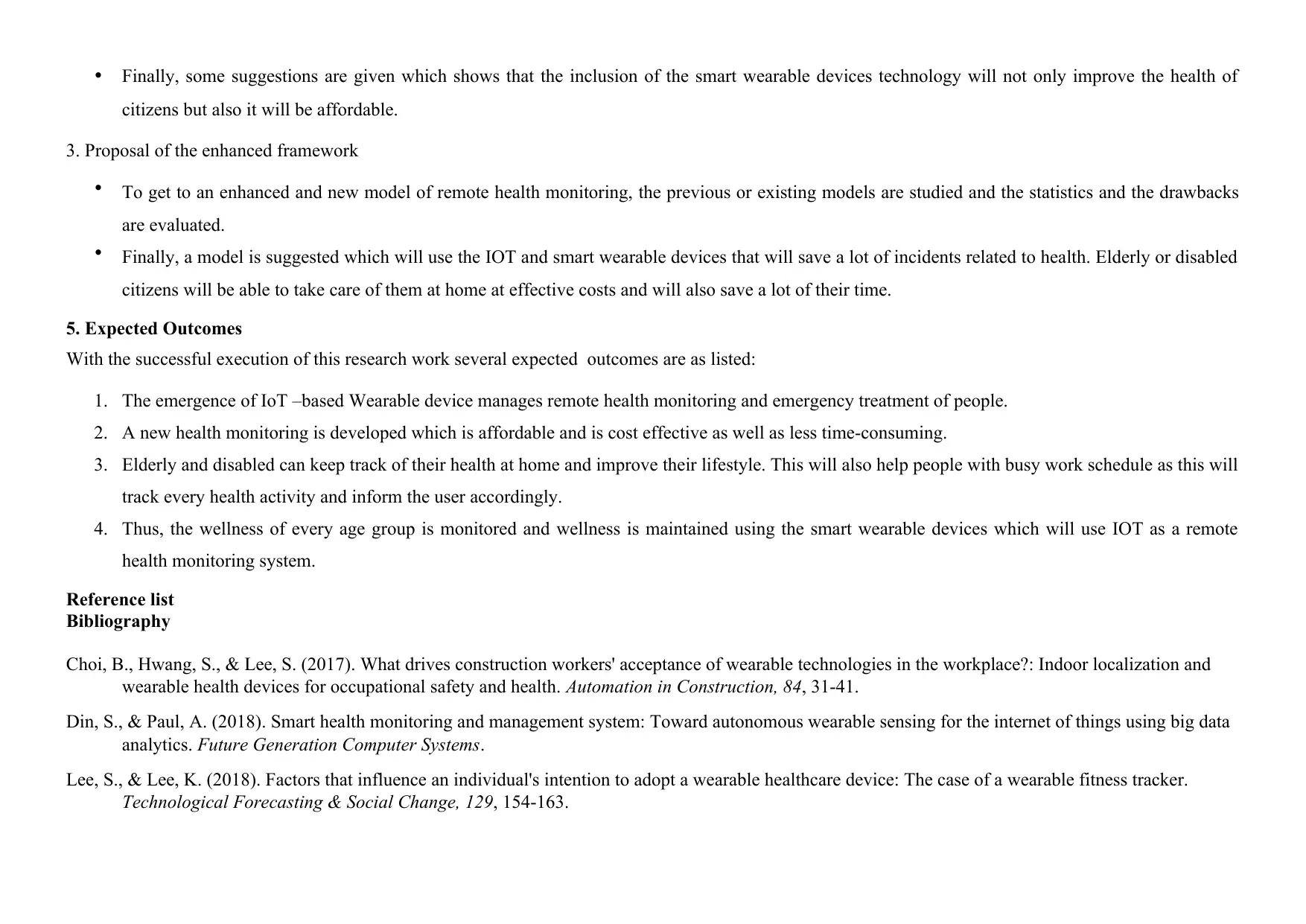
Finally, some suggestions are given which shows that the inclusion of the smart wearable devices technology will not only improve the health of
citizens but also it will be affordable.
3. Proposal of the enhanced framework
To get to an enhanced and new model of remote health monitoring, the previous or existing models are studied and the statistics and the drawbacks
are evaluated.
Finally, a model is suggested which will use the IOT and smart wearable devices that will save a lot of incidents related to health. Elderly or disabled
citizens will be able to take care of them at home at effective costs and will also save a lot of their time.
5. Expected Outcomes
With the successful execution of this research work several expected outcomes are as listed:
1. The emergence of IoT –based Wearable device manages remote health monitoring and emergency treatment of people.
2. A new health monitoring is developed which is affordable and is cost effective as well as less time-consuming.
3. Elderly and disabled can keep track of their health at home and improve their lifestyle. This will also help people with busy work schedule as this will
track every health activity and inform the user accordingly.
4. Thus, the wellness of every age group is monitored and wellness is maintained using the smart wearable devices which will use IOT as a remote
health monitoring system.
Reference list
Bibliography
Choi, B., Hwang, S., & Lee, S. (2017). What drives construction workers' acceptance of wearable technologies in the workplace?: Indoor localization and
wearable health devices for occupational safety and health. Automation in Construction, 84, 31-41.
Din, S., & Paul, A. (2018). Smart health monitoring and management system: Toward autonomous wearable sensing for the internet of things using big data
analytics. Future Generation Computer Systems.
Lee, S., & Lee, K. (2018). Factors that influence an individual's intention to adopt a wearable healthcare device: The case of a wearable fitness tracker.
Technological Forecasting & Social Change, 129, 154-163.
citizens but also it will be affordable.
3. Proposal of the enhanced framework
To get to an enhanced and new model of remote health monitoring, the previous or existing models are studied and the statistics and the drawbacks
are evaluated.
Finally, a model is suggested which will use the IOT and smart wearable devices that will save a lot of incidents related to health. Elderly or disabled
citizens will be able to take care of them at home at effective costs and will also save a lot of their time.
5. Expected Outcomes
With the successful execution of this research work several expected outcomes are as listed:
1. The emergence of IoT –based Wearable device manages remote health monitoring and emergency treatment of people.
2. A new health monitoring is developed which is affordable and is cost effective as well as less time-consuming.
3. Elderly and disabled can keep track of their health at home and improve their lifestyle. This will also help people with busy work schedule as this will
track every health activity and inform the user accordingly.
4. Thus, the wellness of every age group is monitored and wellness is maintained using the smart wearable devices which will use IOT as a remote
health monitoring system.
Reference list
Bibliography
Choi, B., Hwang, S., & Lee, S. (2017). What drives construction workers' acceptance of wearable technologies in the workplace?: Indoor localization and
wearable health devices for occupational safety and health. Automation in Construction, 84, 31-41.
Din, S., & Paul, A. (2018). Smart health monitoring and management system: Toward autonomous wearable sensing for the internet of things using big data
analytics. Future Generation Computer Systems.
Lee, S., & Lee, K. (2018). Factors that influence an individual's intention to adopt a wearable healthcare device: The case of a wearable fitness tracker.
Technological Forecasting & Social Change, 129, 154-163.
Paraphrase This Document
Need a fresh take? Get an instant paraphrase of this document with our AI Paraphraser
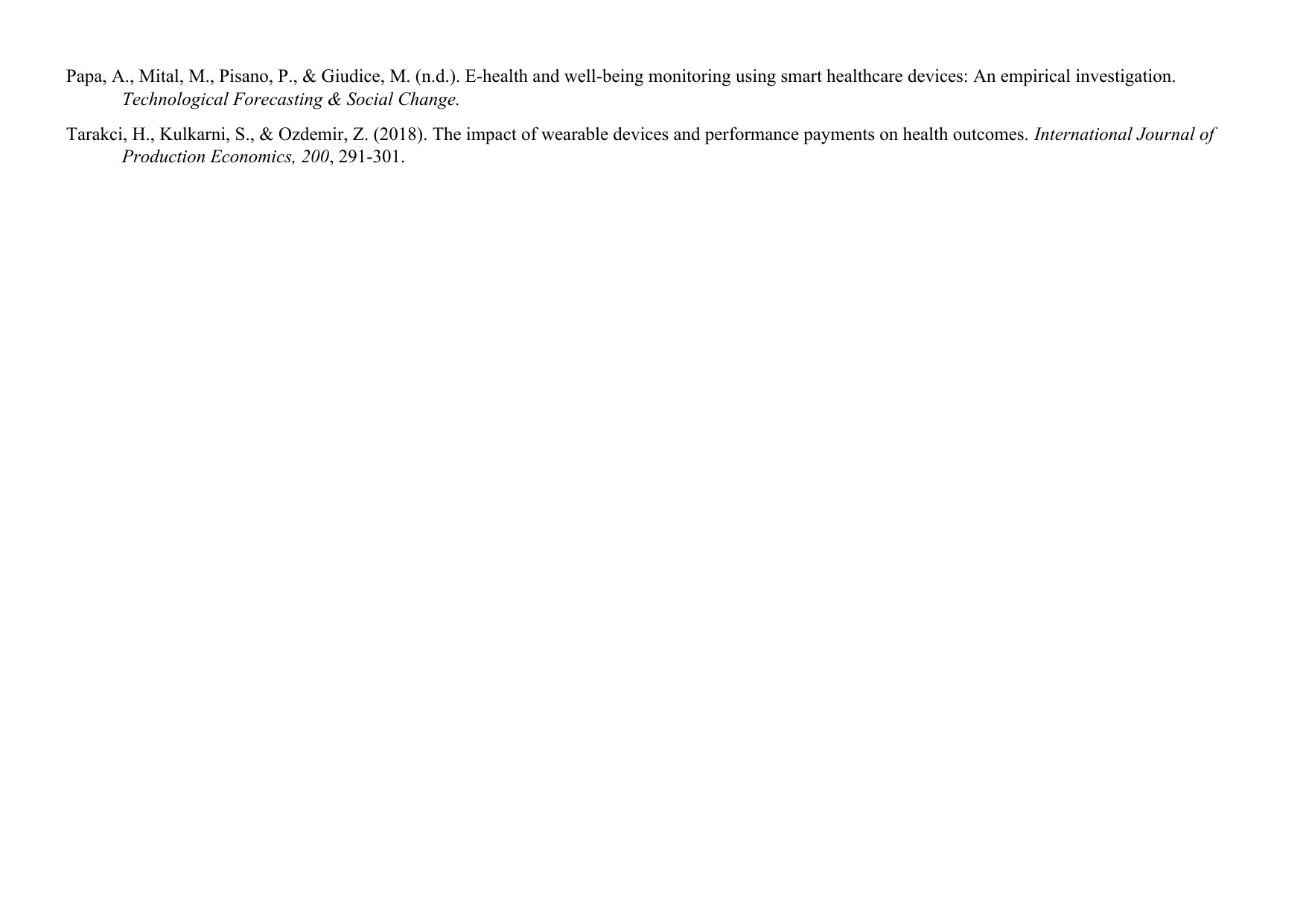
Papa, A., Mital, M., Pisano, P., & Giudice, M. (n.d.). E-health and well-being monitoring using smart healthcare devices: An empirical investigation.
Technological Forecasting & Social Change.
Tarakci, H., Kulkarni, S., & Ozdemir, Z. (2018). The impact of wearable devices and performance payments on health outcomes. International Journal of
Production Economics, 200, 291-301.
Technological Forecasting & Social Change.
Tarakci, H., Kulkarni, S., & Ozdemir, Z. (2018). The impact of wearable devices and performance payments on health outcomes. International Journal of
Production Economics, 200, 291-301.
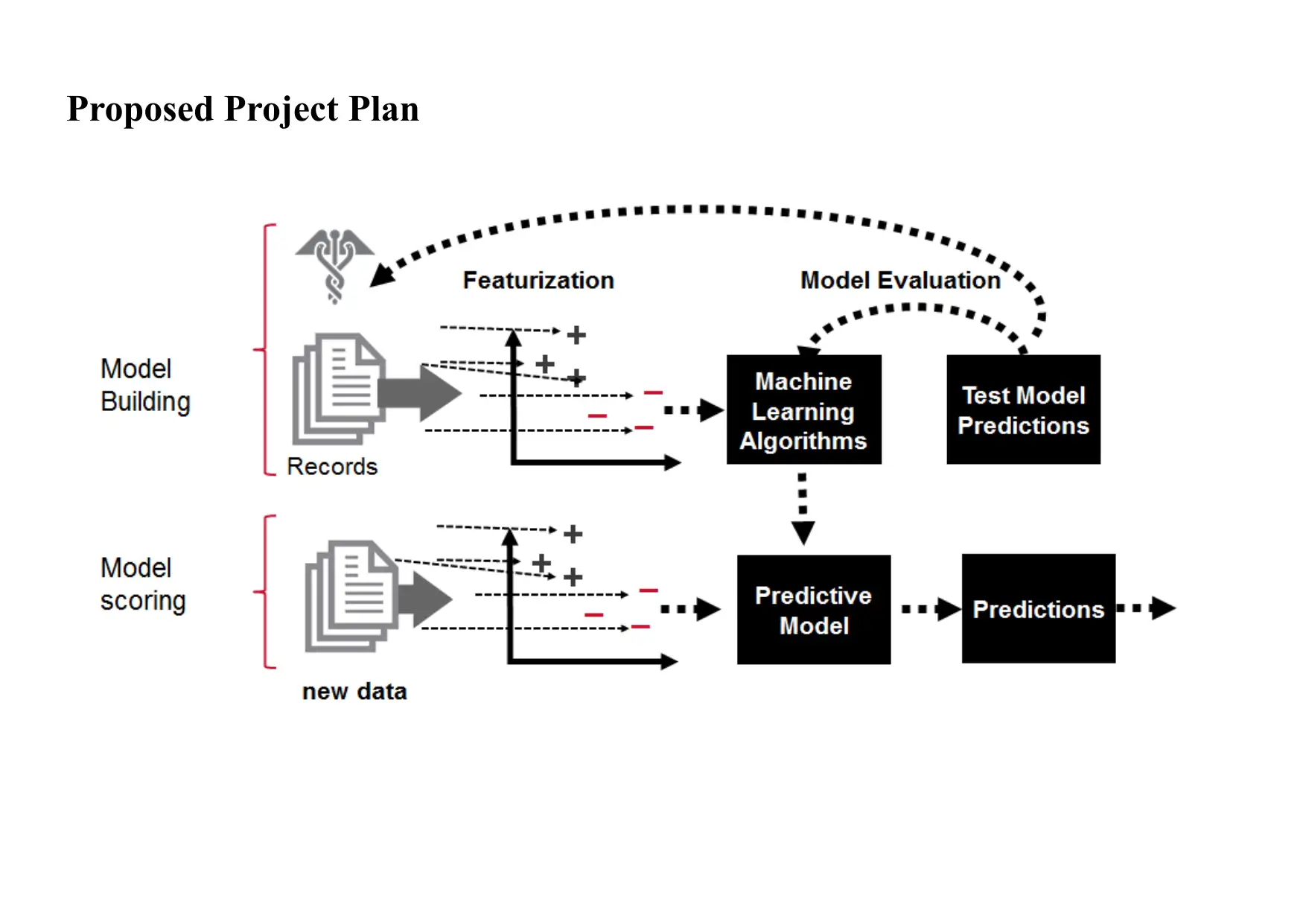
Proposed Project Plan
⊘ This is a preview!⊘
Do you want full access?
Subscribe today to unlock all pages.

Trusted by 1+ million students worldwide
1 out of 6
Related Documents
Your All-in-One AI-Powered Toolkit for Academic Success.
+13062052269
info@desklib.com
Available 24*7 on WhatsApp / Email
![[object Object]](/_next/static/media/star-bottom.7253800d.svg)
Unlock your academic potential
Copyright © 2020–2025 A2Z Services. All Rights Reserved. Developed and managed by ZUCOL.





